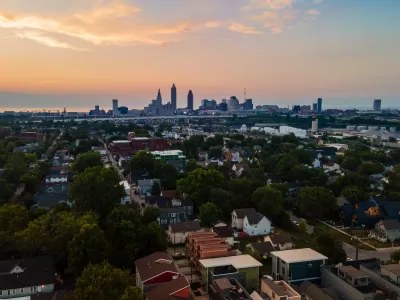If passed by the city council, the new form-based code will be piloted in four neighborhoods.

Cleveland’s planning commission approved new form-based code language and maps last week — after six years of planning and a decade of discussions. It marks the first fundamental change to the city’s zoning code since 1929. “The form-based code is a pilot project, an initiative funded by $275,000 in public money and grants,” reports Michelle Jarboe for News 5 Cleveland. If passed by the City Council,it will initially apply to four areas of the city, with the potential to expand citywide in the years to come.
Many Clevelanders have long considered the city’s current, traditional zoning code to be broken.
According to Jarboe, variances are routine, “whether someone’s adding a deck to a bungalow or building an apartment complex,” but navigating the approval process takes time, money, and knowledge, ultimately discouraging development. Officials hope the more straight-forward form-based code and simpler processes will encourage investment across the city and allow more city residents to establish home-based businesses, which current zoning laws discourage. The new form-based code will also allow more types of homes, including three- and four-unit projects, tiny houses, backyard apartments, and cluster homes, Jarboe reports.
Shannan Leonard, the chief city planner who led the code-reform effort, told News 5 Cleveland that the overall goal is to make zoning more digestible and to better reflect residents’ desires. “We really want to rely on more straightforward, 21st century language, as well as photos and graphics to kind of help people along … We want to be more equitable … We want to be more sustainable. We want to be healthier. And all of those things are wrapped up into zoning,” Leonard said.
FULL STORY: Cleveland Planning Commission OKs major zoning change after a decade of discussions

Trump Administration Could Effectively End Housing Voucher Program
Federal officials are eyeing major cuts to the Section 8 program that helps millions of low-income households pay rent.

Planetizen Federal Action Tracker
A weekly monitor of how Trump’s orders and actions are impacting planners and planning in America.

Ken Jennings Launches Transit Web Series
The Jeopardy champ wants you to ride public transit.

California Invests Additional $5M in Electric School Buses
The state wants to electrify all of its school bus fleets by 2035.

Austin Launches $2M Homelessness Prevention Fund
A new grant program from the city’s Homeless Strategy Office will fund rental assistance and supportive services.

Alabama School Forestry Initiative Brings Trees to Schoolyards
Trees can improve physical and mental health for students and commnity members.
Urban Design for Planners 1: Software Tools
This six-course series explores essential urban design concepts using open source software and equips planners with the tools they need to participate fully in the urban design process.
Planning for Universal Design
Learn the tools for implementing Universal Design in planning regulations.
Ada County Highway District
Clanton & Associates, Inc.
Jessamine County Fiscal Court
Institute for Housing and Urban Development Studies (IHS)
City of Grandview
Harvard GSD Executive Education
Toledo-Lucas County Plan Commissions
Salt Lake City
NYU Wagner Graduate School of Public Service




























